Papers by syahriel abdullah
Incorporated Society of Planters, 2019
Basal Stem Rot (BSR) disease mainly caused by Ganoderma boninense has become a serious threat to ... more Basal Stem Rot (BSR) disease mainly caused by Ganoderma boninense has become a serious threat to the South East Asia oil palm industry. With no conclusive remedy to date, the oil palm industry is still in search of effective ways to manage this disease. The present work reports the effectiveness of organic acids combination (OAC) in managing Ganoderma infection in oil palm. In this study, the pre-formulated organic acids combination from a product to control BSR caused by Ganoderma was carried out both in the field and nursery.
Transactions on Science and Technology, 2016
Basal Stem Rot (BSR) disease caused by Ganoderma spp. is the most devastating disease of oil palm... more Basal Stem Rot (BSR) disease caused by Ganoderma spp. is the most devastating disease of oil palm in Southeast Asia. This paper discusses sustainable approaches in managing BSR disease particularly on early detection and control of Ganoderma with some examples from oil palm estates in Sabah. New detection methods such as ergosterol analysis and Ganoderma signature via Fourier Transform Infrared Spectroscopy (FTIR) are emphasized. Latest disease control methods with great potentials such as combination of biological control agents (BCAs), enhancing defense mechanism of oil palm through enviro-friendly approach, potential biomarkers for selection of resistant breeding materials and utilization of eco-friendly fungicide were also discussed.

Borneo Journal of Medical Sciences, Sep 21, 2018
Background: Community and nosocomialassociated methicillin-resistant Staphylococcus aureus (MRSA)... more Background: Community and nosocomialassociated methicillin-resistant Staphylococcus aureus (MRSA) infections in Malaysian healthcare setting are terrifically increasing in recent years. There is an urgent need for an effective antibacterial agent to cope with this important issue. Due to the development of new antibiotics is not parallel with the increase of cases of infections, researchers have initiated isolation of compounds from natural resources to develop new potent therapeutic agent. Meanwhile, Ganoderma boninense is an oil palm devastating pathogen, which has been known to contain many bioactive compounds that might be potential to be developed as a new source of therapeutic agent. Objectives: To isolate and characterize antibacterial compounds from Ganoderma boninense against methicillinresistant Staphylococcus aureus (MRSA). Methods: Liquid-liquid extraction (LLE) using methanol:chloroform:water (1:1:1) was developed for preliminary isolation of antibacterial compounds from Ganoderma boninense. Active fractions from the LLE were screened for their antibacterial activity using High Performance Thin Layer Chromatographic (HPTLC) bioautography through gradient solvent system separation. The composition of the compounds from the active bands of HPTLC bioautography against methicillinresistant Staphylococcus aureus (MRSA) was further identified with various dereplication methods including the combination of High Performance Liquid Chromatography (HPLC),
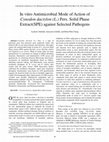
Cynodon dactylon (L.) Pers. is a type of perennial grass that possesses great medicinal values an... more Cynodon dactylon (L.) Pers. is a type of perennial grass that possesses great medicinal values and believed able to cure many diseases and infections. This paper reports the antimicrobial mode of action of C. dactylon Solid Phase extract (SPE) against Bacillus cereus, Bacillus subtilis and Staphylococcus aureus. Mode of action study was done quantitatively via assessment on leakage of 260nm-absorbing materials, fluorometric and luminometric (ATP) assays and qualitatively via Scanning Electron Microscope observation. Assessment on membrane degradation based on 260nm-absorbing material leakage and fluorometric assay showed membrane disruption on B. cereus and B. subtilis after treated with the plant extract. SEM observation further confirmed the membrane disruption. Apart from membrane disruption, luminometric assay based on ATP quantification suggests the bacterial death was due to metabolic suppresion. Liquid Chromatography-Mass Spectrometry (LCMS) analysis revealed some possible an...

Objective: The present study aims to investigate the potential antimicrobial compounds from the f... more Objective: The present study aims to investigate the potential antimicrobial compounds from the fungi against selected foodborne and skin disease pathogens. Methods: In this study, four different types of solvents (hexane, chloroform, dichloromethane and methanol) were used to screen the potential antimicrobial compounds from the G. boninense fruiting bodies. The antimicrobial activity of the G. boninense crude extract was studied against some common food borne and skin diseases bacterial pathogens such as Escherichia coli, Bacillus subtilis, Bacillus cereus, Pseudomonas aeruginosa, Streptococcus pyogenes, Streptococcus pneumoniae, Staphylococcus aureus and Klebsiella spp. using disc diffusion assay. Results: Crude extraction showed methanolic extraction produced the highest yield (2.61%) followed by chloroform (1.36%) and dichloromethane (0.50%). The lowest yield obtained was from hexane extraction (0.17%). Antimicrobial study revealed that methanol and chloroform extracts showed b...
Journal of the Medical Sciences, 2018
Background: Community and nosocomial-associated methicillin-resistant Staphylococcus aureus (MRSA... more Background: Community and nosocomial-associated methicillin-resistant Staphylococcus aureus (MRSA) infections in Malaysian healthcare setting are terrifically increasing in recent years. There is an urgent need for an effective antibacterial agent to cope with this important issue. Due to the development of new antibiotics is not parallel with the increase of cases of infections, researchers have initiated isolation of compounds from natural resources to develop new potent therapeutic agent. Meanwhile, Ganoderma boninense is an oil palm devastating pathogen, which has been known to contain many bioactive compounds that might be potential to be developed as a new source of therapeutic agent. Keywords: Ganoderma boninense, MRSA, Ergosterol, Ganoboninketal, antibacterial, dereplication

The ability of potential antagonists, a commercial product containing combinations of microorgani... more The ability of potential antagonists, a commercial product containing combinations of microorganisms (TR1) to control Ganoderma boninense growth was investigated in this research. TR1 contained multiple strains of Bacillus spp. and Trichoderma spp. The results from field experiments showed that TR1 was all able to reduce the colonization of G. boninense, based on re-isolation of the pathogen onto a selective medium and the reduction of ergosterol content compared to untreated controls. Effectiveness of TR1 was therefore further investigated for mode of action studies. Scanning Electron Microscopy (SEM) observations of Ganoderma mycelium, recovered from bioassay plates on which TR1 had inhibited fungal growth, showed that the mycelium was highly disrupted and lysed after exposure to the treatment. The production of potentially antifungal components produced by TR1 microbes in broth cultures was further investigated using Liquid Chromatography Mass Spectrometry (LCMS). Several antimic...

International Journal of Agriculture and Biology, 2013
Basal Stem Rot (BSR) of oil palm (OP) (Elaeis guineensis) caused by Ganoderma boninense is the mo... more Basal Stem Rot (BSR) of oil palm (OP) (Elaeis guineensis) caused by Ganoderma boninense is the most devastating disease in South East Asia. High incidence of BSR results in economic losses, due to zero yield from dead palms and significantly reduced weight and number of fruit bunches from infected living palms. Although BSR is a very important disease in OP, molecular information on Ganoderma isolates from Sabah, however is not well documented. There is limited information on the use of molecular techniques in identification of G. boninense available in current literature for G. boninense isolates from Sabah. The only report on this pathogen isolate in Sabah is based solely on their morphology and pathogenicity. In conjunction with the morphological similarities between the different isolates, there are also varied opinions on the aggressiveness of the pathogen in Sabah. In this paper we report on the identity of Ganoderma isolates from several OP Estates in Sabah, Malaysia. The ide...

Objective: This study aims to evaluate the phytochemical constituents qualitatively and quantitat... more Objective: This study aims to evaluate the phytochemical constituents qualitatively and quantitatively, as well as the antioxidant and antibacterial activity of extracts from oil palm leaves. Methods: In the present study, both qualitative and proximate (quantitative) phytochemical analysis were carried out using standard methods described previously. Meanwhile, antioxidant activity will be evaluated using DPPH scavenging assay while the antibacterial activity will be evaluated using disc diffusion assay. Results: Crude extraction showed that methanolic extraction produced highest yield (8.28%) followed by hexane (3.10%) and chloroform (3.08%) extraction. Phytochemical screening of methanolic extract of oil palm leaves revealed the presence of phenolic compounds such as flavonoids, tannins, coumarins, alkaloids, saponins, terpenoids, steroids, and carbohydrates. Proximate analysis of phytochemicals in methanolic extracts showed that flavonoids are the main phytochemical constituents...
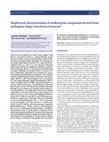
There have been relatively few studies which support a link between Ganoderma boninense , a phyto... more There have been relatively few studies which support a link between Ganoderma boninense , a phytopathogenic fungus that is particularly cytotoxic and pathogenic to plant tissues and roots, and antimicrobial compounds. We previously observed that liquid-liquid extraction (LLE) using chloroformmethanol-water at a ratio (1:1:1) was superior at detecting antibacterial activities and significant quantities of antibacterial compounds. Herein, we demonstrate that antibacterial secondary metabolites are produced from G. boninense mycelia. Antibacterial compounds were monitored in concurrent biochemical and biophysical experiments. The combined methods included high performance thin-layer chromatography (HPTLC), gas chromatography-mass spectrometry (GC-MS), high-performance liquid chromatography (HPLC), fourier transform infrared (FTIR), and nuclear magnetic resonance (NMR) spectroscopy. The antibacterial compounds derived from mycelia with chloroform-methanol extraction through LLE were iso...

Cynodon dactylonis a type of perennial grass that possesses great medicinal values.It is traditio... more Cynodon dactylonis a type of perennial grass that possesses great medicinal values.It is traditionally used as a rejuvenator, for wound healing and was believed to be able to cure many diseases and infections. Scientifically it has been reported to possess many pharmacological activity including antidiabetic, cardioprotective, antidiarrheal and antibacterial properties. However, the role of C. dactylon in combating plant fungal pathogen was scantly reported. In the present study, antifungal activityofC. dactylon ethanol Solid Phase Extraction (SPE) extract against Ganoderma boninense was investigated.The antifungal activity and Minimum inhibitory concentrations (MICs) were evaluated using agar diffusion bioassay. In this study, elute fraction of C. dactylon ethanol SPE extract was effectively suppressed the G. boninense growth after 14 days of incubation (MIC=20.00 mgmL-1). Based on Liquid Chromatography-Mass Spectrometry (LCMS) analysis, some possible antifungal compounds against G...
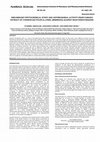
Cynodon dactylon (L.) Pers. is a type of perennial grass that possesses great medicinal values. I... more Cynodon dactylon (L.) Pers. is a type of perennial grass that possesses great medicinal values. In this study, seven different solvents (acetone, chloroform, diethyl ether, ethanol, ethyl acetate, methanol, and n-pentane) were used to investigate the phytochemical constituents of the plant. The antimicrobial activity of the plant crude extract from the selected solvents was investigated against some pathogens ( Bacillus cereus, Bacillus subtilis, Escherichia coli, Klebsiella spp., Pseudomonas aeruginosa, Staphylococcus aureus, Streptococcus pyogenes, and Streptococcus pneumoniae ) using disc diffusion method. Crude extraction showed that ethanolic extraction produced highest yield (7.065%) followed by methanolic (5.420%) and chloroform (3.550%) extraction. The lowest yield obtained from n-pentane extraction (0.500%). Phytochemical studies confirmed the plant contains many bioactive compounds such as alkaloids, cardiac glycosides, terpenoids and steroids, saponins, phenolic compounds...

Journal of Microbiology
Antiplasmodial nortriterpenes with 3,4-seco-27-norlanostane skeletons, almost entirely obtained f... more Antiplasmodial nortriterpenes with 3,4-seco-27-norlanostane skeletons, almost entirely obtained from fruiting bodies, represent the main evidential source for bioactive secondary metabolites derived from a relatively unexplored phytopathogenic fungus, Ganoderma boninense. Currently lacking is convincing evidence for antimicrobial secondary metabolites in this pathogen, excluding that obtained from commonly observed phytochemicals in the plants. Herein, we aimed to demonstrate an efficient analytical approach for the production of antibacterial secondary metabolites using the mycelial extract of G. boninense. Three experimental cultures were prepared from fruiting bodies (GBFB), mycelium cultured on potato dextrose agar (PDA) media (GBMA), and liquid broth (GBMB). Through solvent extraction, culture type-dependent phytochemical distributions were diversely exhibited. Water-extracted GBMB produced the highest yield (31.21 ± 0.61%, p < 0.05), but both GBFB and GBMA elicited remarkably higher yields than GBMB when polar-organic solvent extraction was employed. Greater quantities of phytochemicals were also obtained from GBFB and GBMA, in sharp contrast to those gleaned from GBMB. However, the highest antibacterial activity was observed in chloroform-extracted GBMA against all tested bacteria. From liquid-liquid extractions (LLE), it was seen that mycelia extraction with combined chloroform-methanol-water at a ratio of 1:1:1 was superior at detecting antibacterial activities with the most significant quantities of antibacterial compounds. The data demonstrate a novel means of assessing antibacterial compounds with mycelia by LLE which avoids the shortcomings of standardized methodologies. Additionally, the antibacterial extract from the mycelia demonstrate that previously unknown bioactive secondary metabolites of the less studied subsets of Ganoderma may serve as active and potent antimicrobial compounds.
IOP Conference Series: Earth and Environmental Science
Bangladesh Journal of Pharmacology
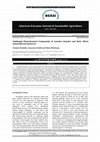
American Eurasian Journal of Sustainable Agriculture, Aug 1, 2014
Cynodon dactylonis a type of perennial grass that possesses great medicinal values.It is traditio... more Cynodon dactylonis a type of perennial grass that possesses great medicinal values.It is traditionally used as a rejuvenator, for wound healing and was believed to be able to cure many diseases and infections. Scientifically it has been reported to possess many pharmacological activity including antidiabetic, cardioprotective, antidiarrheal and antibacterial properties. However, the role of C. dactylon in combating plant fungal pathogen was scantly reported. In the present study, antifungal activityofC. dactylon ethanol Solid Phase Extraction (SPE) extract against Ganoderma boninense was investigated.The antifungal activity and Minimum inhibitory concentrations (MICs) were evaluated using agar diffusion bioassay. In this study, elute fraction of C. dactylon ethanol SPE extract was effectively suppressed the G. boninense growth after 14 days of incubation (MIC=20.00 mgmL-1). Based on Liquid Chromatography-Mass Spectrometry (LCMS) analysis, some possible antifungal compounds against G. boninense were identified as Tokoronin, Ophiopogonin C and Cyclopassiflosides (Saponins), Elemicin (Phenolics), 5-oxo-7octenoic acid, Stearidonic acid and 17-Hydroxylinolenic acid (Fatty acids), Neocnidilide (carboxylic acid), Gingerglycolipid B and Apiole.

International Journal of Pharmacy and Pharmaceutical Sciences, Dec 1, 2013
Objective: This study aims to evaluate the phytochemical constituents qualitatively and quantitat... more Objective: This study aims to evaluate the phytochemical constituents qualitatively and quantitatively, as well as the antioxidant and antibacterial activity of extracts from oil palm leaves. Methods: In the present study, both qualitative and proximate (quantitative) phytochemical analysis were carried out using standard methods described previously. Meanwhile, antioxidant activity will be evaluated using DPPH scavenging assay while the antibacterial activity will be evaluated using disc diffusion assay. Results: Crude extraction showed that methanolic extraction produced highest yield (8.28%) followed by hexane (3.10%) and chloroform (3.08%) extraction. Phytochemical screening of methanolic extract of oil palm leaves revealed the presence of phenolic compounds such as flavonoids, tannins, coumarins, alkaloids, saponins, terpenoids, steroids, and carbohydrates. Proximate analysis of phytochemicals in methanolic extracts showed that flavonoids are the main phytochemical constituents which found to be the highest (257.00 ± 3.055 mg QE/g DW) in oil palm leaves. Antioxidant assay exhibited great antioxidant activity from the methanolic extracts with IC50 value of 0.646 mg mL-1. Meanwhile, the antibacterial activity revealed that methanolic extracts showed broad spectrum activity to all the tested bacteria with inhibition zone of 7.7-11.3 ± 0.0-1.0 mm. Conclusion: The presence of many bioactive compounds such as alkaloid and flavonoid might responsible for the great antioxidant and antibacterial activities which worth to be further explore.

International Journal of Agriculture and Biology, Dec 1, 2013
Basal Stem Rot (BSR) of oil palm (OP) (Elaeis guineensis) caused by Ganoderma boninense is the mo... more Basal Stem Rot (BSR) of oil palm (OP) (Elaeis guineensis) caused by Ganoderma boninense is the most devastating disease in South East Asia. High incidence of BSR results in economic losses, due to zero yield from dead palms and significantly reduced weight and number of fruit bunches from infected living palms. Although BSR is a very important disease in OP, molecular information on Ganoderma isolates from Sabah, however is not well documented. There is limited information on the use of molecular techniques in identification of G. boninense available in current literature for G. boninense isolates from Sabah. The only report on this pathogen isolate in Sabah is based solely on their morphology and pathogenicity. In conjunction with the morphological similarities between the different isolates, there are also varied opinions on the aggressiveness of the pathogen in Sabah. In this paper we report on the identity of Ganoderma isolates from several OP Estates in Sabah, Malaysia. The identities of these isolates were confirmed using DNA sequence analysis after PCR amplification. The latter method showed that the Sabah isolates were very similar to Ganoderma sp with a maximum similarity of 99%.



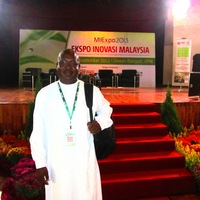





Uploads
Papers by syahriel abdullah